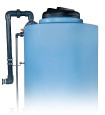A Look At Chemical Storage Tank Expansion Joints
Chemical storage tanks expand and contract due to seasonal temperature variations, pressure changes from loading and unloading the contents within the tank, and vibrations from pumps during filling and discharge from the storage tank.

However, a polyethylene storage tank is only as good as the fittings and accessories you pair it with. For many years, the industry standard was hard piping that came directly into the side of the tank. Because hard piping won’t move with an expanding or contracting sidewall, it can damage a polyethylene tank in several ways:
- Piping vibration from pumps
- Fulcrums that crack the tank
- Hinge points that stress the tank
Flexible expansion joints allow the tank to move as it should while avoiding the damage that rigid piping can cause. (You’ll also need an isolation valve as a backup feature to prevent loss of product and to assist during inspection and maintenance.)
Poly Processing requires flexible connections on tanks larger than 600 gallons.
Poly Processing offers two types of expansion joints, the PTFE Expansion Joint and an EPDM Expansion joint.
The PTFE Expansion Joint and the EPDM Expansion Joint are designed to protect polyethylene tanks by absorbing expansion and contraction, and isolating vibration and shock. The PTFE Expansion Joint is now NSF/ANSI/CAN 61 certified when purchased through Poly Processing company.
Below, you’ll find the minimum parameters for connecting an expansion joint on the bottom third of a polyethylene tank.
 Flexible Connection Minimum Specifications are below: (For common size fittings and piping systems up to 6”) Contact Poly Processing for information on larger expansion joints.
Flexible Connection Minimum Specifications are below: (For common size fittings and piping systems up to 6”) Contact Poly Processing for information on larger expansion joints.
- Axial Compression ≥ .67˝
- Axial Extension ≥ 0.625˝
- Lateral Deflection ≥ 0.51˝
- Angular Deflection ≥ 12°
- Torsional Rotation ≥ 4°
 Poly Processing’s expansion joints are specifically designed and built for plastic chemical storage tanks. The expansion joint:
Poly Processing’s expansion joints are specifically designed and built for plastic chemical storage tanks. The expansion joint:
- Absorbs directional movement. The joint allows axial compression, axial extension, lateral deflection, and angular and torsional movements.
- Absorbs vibration, noise, and shock. This protects your piping and other equipment from vibrational stress caused by mechanical equipment.
Poly Processing Flexible Hose Connection
 Flexible Hose Connections isolate the tank from the stresses and forces associated with pumps and piping. Ultra-high molecular weight hose that makes up these connections offers tremendous chemical resistance. These connections are good choices for transitioning through secondary containment and are available in 1” - 4” sizes.
Flexible Hose Connections isolate the tank from the stresses and forces associated with pumps and piping. Ultra-high molecular weight hose that makes up these connections offers tremendous chemical resistance. These connections are good choices for transitioning through secondary containment and are available in 1” - 4” sizes.
Before Installing Your Flexible Connections
The fittings and accessories are a very important component of designing your chemical storage tank system. Before selecting a flexible connection, there are a few things to consider.
First, you need to understand the space requirements of your tank system. What will the total dimension be of the plumbing with the expansion joint and the tank system?
It’s also important for your flexible connection to be supported properly, but the support shouldn’t restrict the horizontal plane movement of the tank. When using an expansion joint, the pipe support should be placed after the flex to allow the tank to move outward when filled.
If you’re using flexible connectors, it is critical to specify them in the correct specification section. Sometimes engineers will specify flexible connectors in the plumbing specs but not in the tank spec. We recommend including any flexible connectors that you require in your tank specs as well, so we can see them, do a review on the specs, and design a proper tank system.
Once you’ve selected your flexible connection, install it in the correct spot. In most cases, flexible connectors only need to be installed on the lower third of the tank sidewall, since this is the section of the tank that moves the most.
For a flexible connector to serve its purpose, it has to be installed correctly and supported properly. Improperly installed expansion joints can put your chemical tank at risk. If a leak occurs at the joint, you won’t be able to shut off the flow and you will lose good product.
Introduction to Isolation Valves
An isolation valve is a valve that stops the flow of chemicals in or out of the tank. It is installed for maintenance or safety purposes, and you should have an isolation valve at key intersections along with the flow of travel. If a leak develops in the piping or fittings, the valve can be closed upstream to prevent further loss. This saves on the chemical costs and the hassle of cleanup and downtime.
An isolation valve is operated by a quarter turn and uses a floating valve for closure. The position of the handle tells you at a glance if the line is open or shut, giving you peace of mind that the valve is sealed. There are several types of isolation valves, including ball valves, single body isolation valves, top entry isolation valves and split body isolation valves.
Isolation valves are also relatively inexpensive. One-piece isolation valves are easy to replace, two-piece versions are easy to clean, and three-piece versions are easy to repair.
A Danger Hiding in Plain Sight
Improperly installed valves and expansion joints can put your chemical tank at risk. If a leak occurs at the joint, you won’t be able to shut off the flow and you will lose good product.
Our field service teams have seen several examples of improper installations at customer sites. In each case, the facility was confident that they were protected and safe. However, their configuration put them in danger of unnecessarily losing a great volume of product.
For a flexible connector to serve its purpose, it has to be installed correctly and supported properly. The problem arises when some customers place the expansion joint between the fitting and the isolation valve. The purpose of the isolation valve is to shut off the flow if the expansion joint starts to leak, but when the valve is placed after the expansion joint, there is no way to shut off the flow. In this case, a failure in the expansion joint will be unstoppable and the entire contents of the chemical tank can be lost—simply due to improper installation.
You can rely on Poly Processing to ensure that your flexible connectors are properly installed and functioning as intended. Talk to a field service expert today.
- January 27, 2025
- Topics: Fittings and Accessories
About Poly Processing
Posts By Topic
Tech Talk Podcast Episodes
Subscribe By Email
Recent Posts
- Maximizing Fill Efficiency: Selecting the Optimal Fill Line System
- Chemical Storage Tanks: A Quick Guide for End Users
- Popular Customization Options for Chemical Storage Tanks
- Understanding Flood Zones Under the IBC: Building Requirements and Insurance Implications
- Choosing Between Steel, Polyethylene, and Fiberglass Tanks: What You Need to Know
Tank Configurator

Find the recommended tank and system components for your chemical storage challenge.
Configure a Tank Package








